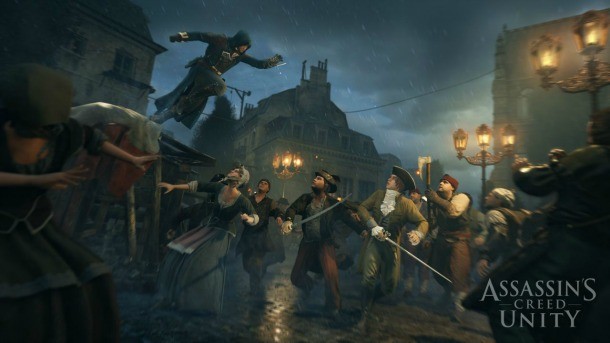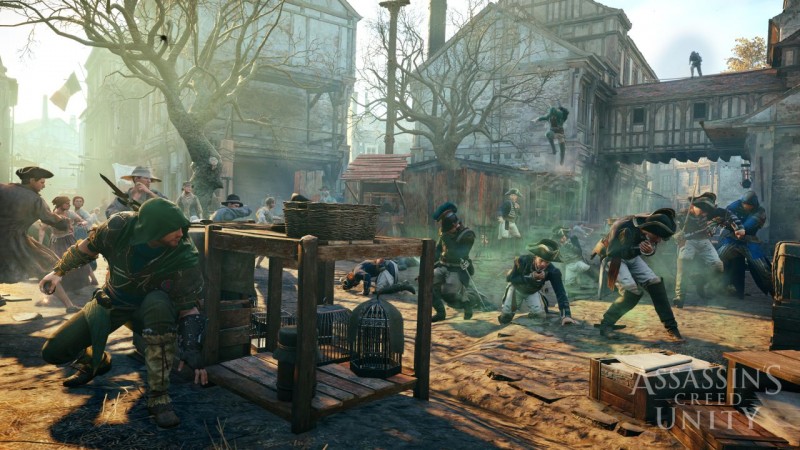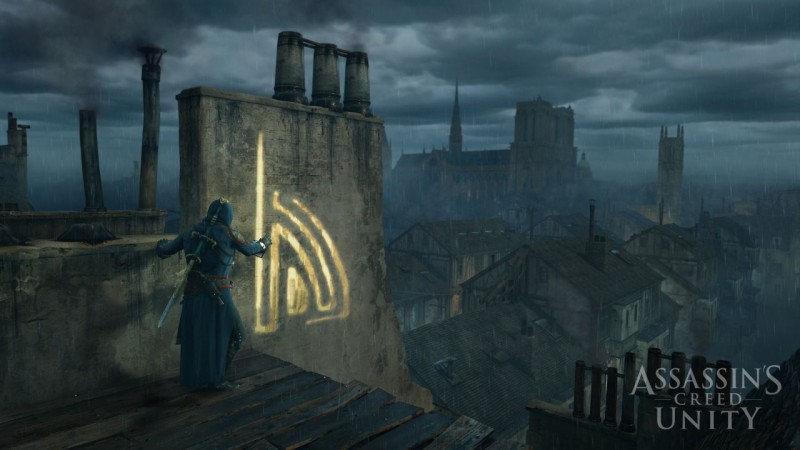Please support Game Informer. Print magazine subscriptions are less than $2 per issue
Assassin's Creed Unity

Ever since its announcement, Ubisoft has declared that Assassin’s Creed Unity is a fresh start for the franchise. Beyond the new setting of French Revolution-era Paris, the philosophy of change extends to gameplay, character progression, and online integration. I recently had the chance to see those changes first-hand and dive into an early preview build for five hours of exploration. More than anything, I was struck by how profoundly different Unity feels from recent entries in the franchise, and the ways in which a few core structural features recall the earliest games in the series.
Built Around Character Progression
One of Unity’s biggest changes is the focus on character growth and progression. Arno is constantly acquiring various currencies to improve both his skills and gear, and the game provides a large number of customization options along the way. Money is used to buy new gear and equipment, and skill points provide fundamentally new abilities. Sync points allow players to upgrade those abilities. Finally, hack points are bought with real money, and let you have a shortcut to purchasing powerful items – sometimes much sooner than you could get them otherwise.
The customization options are vast. Arno wears multiple costume pieces, from his hood to his boots and everything in between, and every one of those slots can be a custom-selected clothing item, ensuring your Arno looks different from everyone else’s version of the character. This distinction is furthered by the option to purchase color schemes to overlay on top of any given outfit.
Similarly, a broad selection of weapons is available to Arno, including classic one-handed blades, heavy maces, and long weapons like spears and polearms. Every weapon type has many options to choose between, each with different stats of damage and speed. Customizing Arno’s loadout and look is good fun, and one of my favorite features of what I played.
I have more mixed feelings about the ability to level Arno’s core abilities. Many of the fundamental features that players take for granted in the beginning of an AC game are now locked behind a progression gate. For instance, blending/hiding by sitting down on a bench is now an ability to purchase, rather than an inherent skill. Early in the game, eagle vision can only be used for a limited time, and afterwards has a cooldown before it can be used again. For experienced players, it feels a little like you’re hobbled right out of the gate. However, it no doubt provides a sense of Arno moving from a know-nothing to what I hope will be an experienced, expert assassin by the end of the game.

A Focus On Stealth
Assassin’s Creed has often struggled with traditional stealth, but Unity is moving deeper into it rather than further away. Taking cues from Ubisoft’s spy thriller, Splinter Cell, many missions now see Arno remaining crouched and moving slowly to avoid enemy detection. In another nod to that franchise, the “last known location” mechanic plays a major role in passing through protected areas. Once spotted, a transparent outline of your last location shows up on screen and attracts enemy attention. You can use this info to move past quickly or circle behind an enemy for a quick kill.
During my time wandering the streets and rooftops of Paris, the need for stealth was constant. Enemy forces seem much better at spotting you than in previous installments, including tracking you from the ground while you are on the roof. One interesting counter to enemy detection is the incredible crowd density in the streets of the city. By exiting stealth and walking normally into a large group, attackers often become confused and lose you in the throng.
Punishing Combat
When both stealth and retreat fail, it’s time to engage in Unity’s entirely reimagined combat system. While new moves, attacks, and defenses show up all the time, the core controls are built around three buttons – attack, parry, and dodge. Each must be carefully timed. Button mashing is absolutely not an option. The attack button results in a variety of exciting assault animations, but guards regularly block repeated attacks. The parry button is essential, but unfortunately, the signal that an enemy is attacking is only clearly visible when your attacker is in view; some off-screen attackers would devastate Arno since I couldn’t see the attack coming in. Finally, the dodge button is an exciting new addition, but one that takes a good bit of getting used to. It’s a quick way to move out of danger, but is by no means a surefire way to avoid getting hurt.
Enemies do significantly more damage than ever before, especially early in the game, which included the section I was playing. Even with broad expertise using every combat system Assassin’s Creed has offered since 2007, I was regularly killed in battles with just a few enemies as I attempted to adjust to the new mechanics. As soon as three or more enemies arrive, they are likely to begin using ranged weapons on you, and I was unable to find an effective counter. Enemy rifles and pistols have the potential to kill you in one or two shots, so climbing away from a battle is rarely an option.
In short, combat is built to be significantly more dangerous and difficult than ever before. Where previous assassin characters have reveled in the opportunity to bring down large number of attackers with skilled combat, this new assassin must proceed much more carefully if he hopes to survive.
[Next Page: A new approach to mission structure, and the arrival of cooperative play]

Open Mission Structure
In a move that recalls the origins of the franchise in the first Assassin’s Creed game, Unity offers a more open mission structure than recent installments. This welcome change means the player often has numerous paths to complete an assassination, all viable if played with care.
In one mission, I needed to infiltrate Notre Dame Cathedral to bring down a Templar agent. In my first attempt, I caused a distraction to draw guards away from the front entrance and then snuck inside, but was killed by another group of guards just past the entryway. A second attempt had me climbing along the exterior walls of the cathedral until I found an open window. Unfortunately, once inside, I was spotted by my target and his numerous nearby minions shot me dead. In a third attempt, I stole keys that unlocked a door in one of the cathedral’s towers. I descended to ground level, and then traveled through the nave to reach a confessional booth. When my target eventually arrived inside, I stabbed him through the screen and then escaped into a nearby catacomb beneath the church.
Many missions in Unity offer this level of flexibility, and reward taking the extra time to set up a thoughtfully imagined solution. Ubisoft has stated that this variable approach to mission completion is part of a strategy called the adaptive mission mechanic, and I’m eager to see the other ways in which missions can branch in different directions. I enjoy the opportunity for improvisation, but some players may find the openness to be disconcerting after the more guided mission structure of recent entries.
Two Branches Of Cooperative Play
The competitive cat-and-mouse game modes that have been part of the franchise since Brotherhood are not present in Unity. Instead, the multiplayer experience is now wholly cooperative, and takes the form of two distinct game modes that unfold within the larger single-player story.
The first of these modes are the Brotherhood missions. These two player missions together encompass a concurrent story with Arno’s single-player adventure. The single-player story focuses primarily on Arno’s quest to avenge his adoptive father, but seems to stay away from many of the more well-known moments and characters of the French Revolution. Those characters (including an appropriately villainous Robespierre) instead play a central role in the two-player co-op missions. With only one other player to rely upon, these story-driven missions require a careful approach and constant teamwork. In practice, these missions remind me once again of the recent Splinter Cell games, most particularly those found in Blacklist.
The second selection of mission type is a four-player heist. Primarily billed as a way to make some extra money for Arno’s many optional upgrades, heist missions are fun and quick diversions with less of a story focus, and more randomness each time you play. In the mission I played, I joined three other assassins as we infiltrated a mansion to steal back some ill-gotten artwork. Each time you play a heist mission, the guards are in new places, different windows are open, and objective locations switch around, assuring enjoyable replay. With four assassins on the case, it was easier to rush headlong into the thick of things, but the final reward lowers each time you raise an alarm.
Between over a dozen Brotherhood missions and seven heists, a lot of content is built specifically with multiplayer in mind. I was also told by Ubisoft that players are able to remain in groups after missions and wander freely through the open world.

The Second Screen Experience
Based on recent releases and convention appearances, it’s clear that Ubisoft is investing big in the opportunity for second-screen integration, encouraging players to engage with a mobile app both during gameplay and in-between sessions. During my hours with Unity, I got to see an extended demo of the companion app, and it’s the first time I’ve felt like a companion app is essential for full enjoyment of a game.
Unity’s companion app offers several options for interaction, but the central (and perhaps most useful) tool is the inclusion of a real-time map of your in-game session. Your tablet or phone exhibits a full map of Paris with all of the same icons you see in the main game’s pause screen, but without needing to leave the action. You can zoom and rotate this mobile version of the map to find the best view of the action. Moreover, any icon can be tapped and held, and within just a few seconds, that objective marker shows up in the main game. The map also includes regularly updated heat maps that show you where other players are going in the city, as well as where and how they completed individual missions. The map becomes a great tool to stay immersed in the game world on your TV while a second screen acts as a navigation tool.
The companion app also allows for a couple of other fun activities that can be tackled even if you’re away from the main Unity game. Glyph puzzles unlock as you find different landmarks during your journeys through Paris. In the app, a model of that landmark appears, and you must search out hidden glyphs on the structure. It’s a simple but tangible connection to these architectural wonders, but it’s only an option within the app.
By completing glyph puzzles, you’ll unlock one of 63 nomad missions, the other major gameplay component of the companion app. Previous versions of Assassin’s Creed have often included a mini-game about building up a force – from missions across the Mediterranean to sailing fleets filled with cargo. Nomad missions fulfill this role in Unity, but they are only available through the companion app. Within the app, players can build up new individual assassins, assigning skills like health, stealth, attack, and defense. Each mission requires a different combination of skills, so it’s essential to build up a well-balanced team.
Upon completion of each nomad mission, a reward unlocks in the main game, often as a blue chest that is discoverable in the game world. These chests can include all sorts of bonuses, including entirely new outfits for Arno to wear.
The app is the most impressive second-screen experience I’ve yet seen, offering a number of fun tools to stay connected to Unity. However, it’s easy to guess that some players may be frustrated that the app is now virtually required if you want to experience Unity in full.
My time with Assassin’s Creed Unity barely scratched the surface of the available content. It’s clear that the game is filled with mission opportunities, exploration, and lots of upgrading. As a longtime player, I came away surprised at the breadth of changes in store, and I need plenty more time with the game before I decide for sure whether I like all the changes. In the meantime, I can confidently state that Unity is charting new territory for the franchise – players who are eager for a shake-up are getting their wish.











